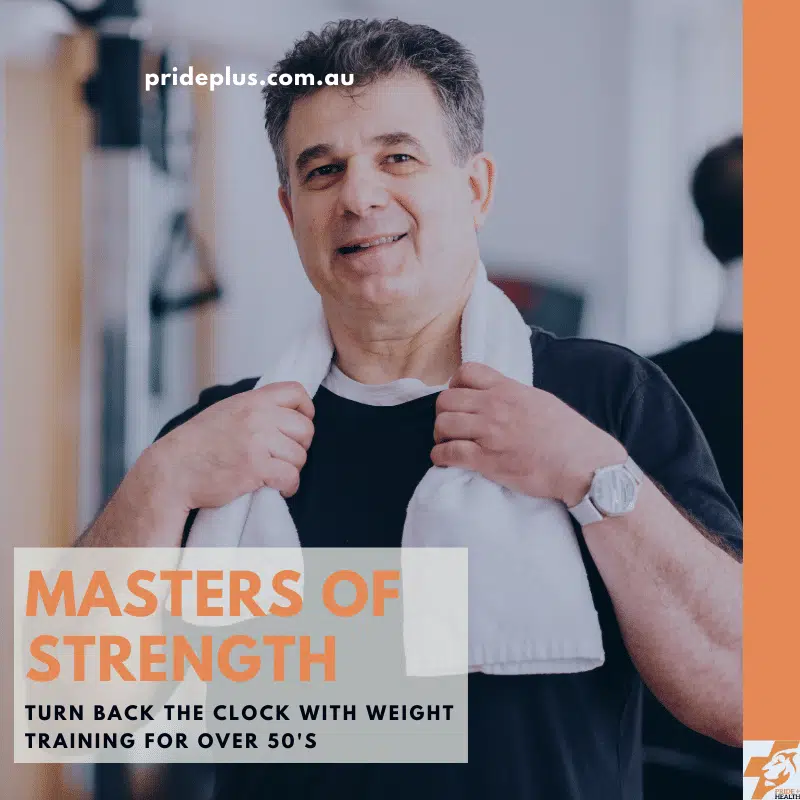Starting November 15th 2021 – MASTERS OF STRENGTH
Masters of Strength is a physiotherapy and exercise physiologist lead gym program for the over 50s.
If you’re ready to turn back the clock join your fellow Masters by booking your first session here.
I’m Getting Too Old For This
When was the last time you heard yourself say that?
Are you feeling more aches and pains, stiffness and slowing down.
And, even the simple backyard jobs are taking longer than they used to.
At Masters of Strength we’re here to provide you with an alternative experience of life past 50.
Remember the confidence you had in your physical capabilities?
Your power, stamina and agility?
At Pride we believe in you. With Masters of Strength you can get there again.
How To Turn Back The Clock
Turn back the clock with Masters of Strength by getting strong, real strong.
As we age we gradually lose our muscle strength, tendon elasticity, joint mobility and bone density.
We know what we need to do, we’re all told to exercise regularly but some habits die hard, and others die quick.
By reconnecting with safe weight training you can stop the losses and even reverse them.
Don’t just take our words for it, it’s been proven in the scientific literature over, and over, and over again with plenty more references at the end of this page.
Safety First
We developed Masters of Strength as there was a shortage of exercise expertise in the community for many age related health conditions.
Cardiovascular disease, diabetes, arthritis and muscle injuries are all common once we get over 50. These factors all need to be considered when designing a personal weight training exercise plan.
So Masters of Strength is run by trainers who are exercise physiologists and physiotherapists. Two allied health professions whose expertise in health and wellness as well as injury and disease gives you a foundation to safely build on.
Masters of Strength Involves
All Masters start with a one-on-one physical tune up session with either physiotherapist Dominic or exercise physiologist Aidan. In the tune up session you’ll be tested and have your training plan developed. We conduct the tune up sessions in our clinic at 124 Kent Rd Pascoe Vale (within PVH Medical) where access to testing and training equipment is readily at hand.
After your one-on-one physical tune up you’ll be ready for the big time.
Masters of Strength classes are small groups of less than 6 Masters at a time. We hold the classes inside the brand new facilities of fitspace (8/39 Essex St, Pascoe Vale) at (times).
During the classes you’ll be working with your physio and exercise physiologist on lifting progressively heavier weights.
You’ll be mastering the bench press, squats, deadlifts and other fundamentals.
Sign Me Up
Masters of Strength is the first of it’s kind in Melbourne with limited places available. To sign up you must first book in for your physical tune up with physio Dominic Tan or exercise physiologist Aidan Rogers. To do that you simple choose an “Initial Appointment” as the appointment type with either Aidan or Dominic below.
Start with Dominic
Start with Aidan
Join a class
Schedule AppointmentThe Cost
Your one-on-one physical tune up session to start is $65. This only needs to be completed one time to start the program. After that all 50 minute small group training sessions are $30.
The Evidence For Weight Training
The evidence for weight training as we age is so overwhelmingly positive that we’re including the following bibliography. Whether it be improving bones, muscles, mental health, chronic disease or mood, lifting with the Masters of Strength program will be a great positive in your life.
Lifting for Bones & Posture
- Layne, J. E., & Nelson, M. E. (1999). The effects of progressive resistance training on bone density: a review. Medicine and science in sports and exercise, 31(1), 25-30.
- Watson, S. L., Weeks, B. K., Weis, L. J., Horan, S. A., & Beck, B. R. (2015). Heavy resistance training is safe and improves bone, function, and stature in postmenopausal women with low to very low bone mass: novel early findings from the LIFTMOR trial. Osteoporosis International, 26(12), 2889-2894.
- Watson, S. L., Weeks, B. K., Weis, L. J., Harding, A. T., Horan, S. A., & Beck, B. R. (2019). High-intensity exercise did not cause vertebral fractures and improves thoracic kyphosis in postmenopausal women with low to very low bone mass: the LIFTMOR trial. Osteoporosis International, 30(5), 957-964.
- Harding, A. T., Weeks, B. K., Watson, S. L., & Beck, B. R. (2017). The LIFTMOR-M (Lifting Intervention For Training Muscle and Osteoporosis Rehabilitation for Men) trial: protocol for a semirandomised controlled trial of supervised targeted exercise to reduce risk of osteoporotic fracture in older men with low bone mass. BMJ open, 7(6), e014951.
- Harding, A. T., Weeks, B. K., Lambert, C., Watson, S. L., Weis, L. J., & Beck, B. R. (2020). A comparison of bone‐targeted exercise strategies to reduce fracture risk in middle‐aged and older men with osteopenia and osteoporosis: LIFTMOR‐M semi‐randomized controlled trial. Journal of Bone and Mineral Research, 35(8), 1404-1414.
- Hong, A. R., & Kim, S. W. (2018). Effects of resistance exercise on bone health. Endocrinology and Metabolism, 33(4), 435.
- Kraemer, W. J., Häkkinen, K., Newton, R. U., Nindl, B. C., Volek, J. S., McCormick, M., … & Evans, W. J. (1999). Effects of heavy-resistance training on hormonal response patterns in younger vs. older men. Journal of applied physiology, 87(3), 982-992.
- Pinheiro, M. B., Oliveira, J., Bauman, A., Fairhall, N., Kwok, W., & Sherrington, C. (2020). Evidence on physical activity and osteoporosis prevention for people aged 65+ years: a systematic review to inform the WHO guidelines on physical activity and sedentary behaviour. International Journal of Behavioral Nutrition and Physical Activity, 17(1), 1-53.
Exercise & Diabetes
- Williams, A., Radford, J., O’Brien, J., & Davison, K. (2020). Type 2 diabetes and the medicine of exercise: the role of general practice in ensuring exercise is part of every patient’s plan. Australian journal of general practice, 49(4), 189.
- Colberg, S. R., Sigal, R. J., Fernhall, B., Regensteiner, J. G., Blissmer, B. J., Rubin, R. R., … & Braun, B. (2010). Exercise and type 2 diabetes: the American College of Sports Medicine and the American Diabetes Association: joint position statement. Diabetes care, 33(12), e147-e167.
Lifting for Balance
- Granacher, U., Lacroix, A., Muehlbauer, T., Roettger, K., & Gollhofer, A. (2013). Effects of core instability strength training on trunk muscle strength, spinal mobility, dynamic balance and functional mobility in older adults. Gerontology, 59(2), 105-113.
- Granacher, U., Gollhofer, A., Hortobágyi, T., Kressig, R. W., & Muehlbauer, T. (2013). The importance of trunk muscle strength for balance, functional performance, and fall prevention in seniors: a systematic review. Sports medicine, 43(7), 627-641.
- Ding, L., & Yang, F. (2016). Muscle weakness is related to slip-initiated falls among community-dwelling older adults. Journal of biomechanics, 49(2), 238-243.
- Persch, L. N., Ugrinowitsch, C., Pereira, G., & Rodacki, A. L. (2009). Strength training improves fall-related gait kinematics in the elderly: a randomized controlled trial. Clinical Biomechanics, 24(10), 819-825.
Lifting for Strength and Improving/Maintaining Muscle Mass
- Vikberg, S., Sörlén, N., Brandén, L., Johansson, J., Nordström, A., Hult, A., & Nordström, P. (2019). Effects of resistance training on functional strength and muscle mass in 70-year-old individuals with pre-sarcopenia: a randomized controlled trial. Journal of the American Medical Directors Association, 20(1), 28-34.
- Fielding, R. A. (1995). The role of progressive resistance training and nutrition in the preservation of lean body mass in the elderly. Journal of the American College of Nutrition, 14(6), 587-594.
- Aagaard, P., Suetta, C., Caserotti, P., Magnusson, S. P., & Kjær, M. (2010). Role of the nervous system in sarcopenia and muscle atrophy with aging: strength training as a countermeasure. Scandinavian journal of medicine & science in sports, 20(1), 49-64.
Lifting for Back Pain
- Steele, J., Bruce-Low, S., Smith, D., Osborne, N., & Thorkeldsen, A. (2015). Can specific loading through exercise impart healing or regeneration of the intervertebral disc?. The Spine Journal, 15(10), 2117-2121.
Lifting for Hypertension
- Lemes, Í. R., Ferreira, P. H., Linares, S. N., Machado, A. F., Pastre, C. M., & Netto, J. (2016). Resistance training reduces systolic blood pressure in metabolic syndrome: a systematic review and meta-analysis of randomised controlled trials. British journal of sports medicine, 50(23), 1438-1442.
- Cornelissen, V. A., Fagard, R. H., Coeckelberghs, E., & Vanhees, L. (2011). Impact of resistance training on blood pressure and other cardiovascular risk factors: a meta-analysis of randomized, controlled trials. Hypertension, 58(5), 950-958.
Lifting for Mental Health
- Moraes, H. S., Silveira, H. S., Oliveira, N. A., Portugal, E. M. M., Araújo, N. B., Vasques, P. E., … & Deslandes, A. C. (2020). Is strength training as effective as aerobic training for depression in older adults? A randomized controlled trial. Neuropsychobiology, 79(2), 141-149.
Lifting for Cognition
- de Camargo Smolarek, A., Ferreira, L. H. B., Mascarenhas, L. P. G., McAnulty, S. R., Varela, K. D., Dangui, M. C., … & Souza-Junior, T. P. (2016). The effects of strength training on cognitive performance in elderly women. Clinical interventions in aging, 11, 749.
- Mavros, Y., Gates, N., Wilson, G. C., Jain, N., Meiklejohn, J., Brodaty, H., … & Fiatarone Singh, M. A. (2017). Mediation of cognitive function improvements by strength gains after resistance training in older adults with mild cognitive impairment: outcomes of the study of mental and resistance training. Journal of the American Geriatrics Society, 65(3), 550-559.
Lifting for Physical Function
- Liu, C. J., & Latham, N. K. (2009). Progressive resistance strength training for improving physical function in older adults. Cochrane database of systematic reviews, (3).
Lifting and Injury
- Siewe, J., Rudat, J., Röllinghoff, M., Schlegel, U. J., Eysel, P., & Michael, J. P. (2011). Injuries and overuse syndromes in powerlifting. International journal of sports medicine, 32(09), 703-711.
Age & Performance
- Solberg, P. A., Hopkins, W. G., Paulsen, G., & Haugen, T. A. (2019). Peak age and performance progression in world-class weightlifting and powerlifting athletes. International journal of sports physiology and performance, 14(10), 1357-1363.
Plyometrics for Seniors
- Zubac, D., Paravlić, A., Koren, K., Felicita, U., & Šimunič, B. (2019). Plyometric exercise improves jumping performance and skeletal muscle contractile properties in seniors. Journal of musculoskeletal & neuronal interactions, 19(1), 38.
- Hoffrén-Mikkola, M., Ishikawa, M., Rantalainen, T., Avela, J., & Komi, P. V. (2015). Neuromuscular mechanics and hopping training in elderly. European journal of applied physiology, 115(5), 863-877.
High Intensity Exercises
- Nybo, L., Sundstrup, E., Jakobsen, M. D., Mohr, M., Hornstrup, T., Simonsen, L., … & Krustrup, P. (2010). High-intensity training versus traditional exercise interventions for promoting health. Medicine & Science in Sports & Exercise, 42(10), 1951-1958.
- Caserotti, P., Aagaard, P., Buttrup Larsen, J., & Puggaard, L. (2008). Explosive heavy‐resistance training in old and very old adults: changes in rapid muscle force, strength and power. Scandinavian journal of medicine & science in sports, 18(6), 773-782.
Exercise Dosing
- Bickel, C. S., Cross, J. M., & Bamman, M. M. (2011). Exercise dosing to retain resistance training adaptations in young and older adults. Medicine & Science in Sports & Exercise, 43(7), 1177-1187.




